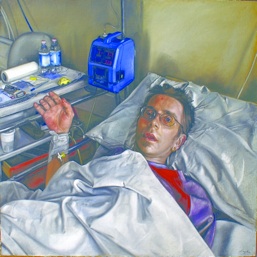Bioethics Made Personal: An Interview with UNESCO Chair Global Art Competition Board Member on the Artistic and Ethical Significance of the Exhibit
An interview with Hallie Moore by Michael Baggot
What is the value of the UNESCO Chair Global Art Exhibit?
This exhibit offers the viewer insights into accomplished artists’ capacity to make visible such abstractions as “vulnerability.” We are creatures who with our five senses understand the objective world. We can see, smell, feel, hear, taste the sensory world. But the abstract concepts that this exhibit highlights: respect for the vulnerable, concern for the ethics of life, these are difficult ideas. Such an exhibit as this one, puts a face on these abstractions. We see the aged, the ill, the impoverished and forgotten, and we are moved to offer compassion.
What role does art play in bioethical and human rights issues?
Art makes visible what man may struggle to understand. The Visual Arts make concrete and –in the case of many of these images — personal what may have merely been a vague notion before. “Lorenzo” stares out at the viewer from his hospital bed and maze of machinery and tubes. He comes into our minds and hearts; his suffering becomes real.

What inspired your involvement in the competition?
I am a perfect example of the typical art museum attendee. I wandered through these images… originally over 200 hundred of them… glancing here, glancing there, trying very hard to understand what the theme meant to me. It was not until our Board had sifted through the submissions and we had talked and talked about why this image reflected the theme of vulnerability and this one did not, that I began to understand and appreciate the intention of this competition to open viewers’ eyes. Seeing the image of “Olga” stretching her arm out as if it were a stranger to her, captured me. I was part of her dementia and felt empathy. Involvement in this competition has schooled me in “respect for the vulnerable” and I have been gifted with its knowledge.
Could you summarize your contribution to the realization of the competition?
My title is best described as corresponding secretary. I informed each artist that their submission had been received and later informed them of their status in the on-going judging. Each member of the Board supported the entire process, whether it was processing the submissions, seeking donations to the competition, encouraging the young musicians who created the original composition for the exhibit, preparing food for the first exhibit, or acting as a sounding board for the documentary. We were all multi-tasking.
Do you think that the artistic community needs a deeper awareness of and appreciation for bioethical and human rights issues?
That is hard to say. I think bioethics and human rights is a topic that all thoughtful people need to address. As the planet shrinks, as communication with each other becomes more immediate, as our capacity for speeding ahead in technology increases, all of us, artists and non-artist alike, are called to wrestle with these ethical issues regarding bioethics and human rights. Our claim to humanity calls us to reflect on what is just.
Do you think that those involved in bioethics and the promotion of human rights have a need for a deeper appreciation of art?
Art is another language and this language crosses all boundaries and borders. It is a broad highway that doctors, philosophers, politicians, clergy, and the layman can travel. The journey may lead to a deeper appreciation.
What advice would you give artists seeking to explore bioethical/human rights issues in their work?
Find their source of compassion. What person, event, image evokes their deepest concern for humanity? Is it a child in need, a homeless person sleeping in a doorway, a frightened man in a clinic waiting room? Find the provocative moment and find a way to share that.
What events, projects or developments do you foresee arising from the Global Art Exhibit?
This exhibit will be share with the Bioethics and Human Rights Conference in Rome this month. It will return to Texas for two additional exhibitions. The website (www.bioethicsart.org) will continue to instruct and encourage viewers to look into the heart of this issue of bioethics and human rights. Who knows who will be inspired to act, either through art or some other means to offer one’s talent to mankind’s ethical progress.

